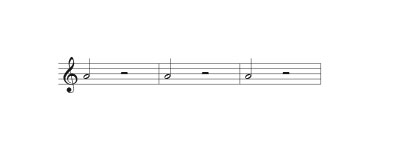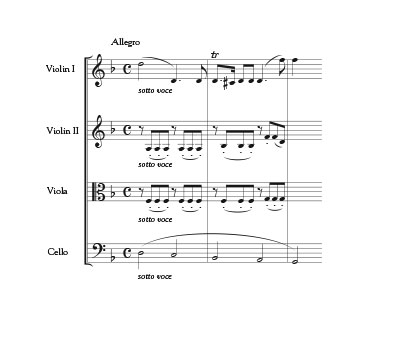Coaching small ensembles to prepare students for various music competitions can be a daunting task, particularly for music educators who primarily have been trained to conduct large ensembles. The conductor of a large ensemble rehearses the group, corrects problems, and provides the inspiration for a successful performance. In a small ensemble, however, there is no conductor, and different skills are required for success. Thus, the teacher’s task must be to emphasize and encourage development of those skills that will best suit a small ensemble performance.

Learning to Lead and Follow
Apart from the first reading of the composition or a difficult section that would benefit from guidance, the teacher should refrain from conducting or counting out loud. This will be difficult at first for students unaccustomed to leading and following their peers.
Develop this skill through games that encourage leading and following. Choose any concert pitch (the key of the composition or the tuning note are ideal choices) and have each member of the group lead the start of that note. Explain to the group that everyone will need to inhale at the same time as the leader. The leader will also need to make a gesture (upbeat) indicating the tempo and entrance of the note. Have the ensemble repeat this:

At the end of the exercise ask ensemble members to critique the performance. Good questions include whether they were all together at the start of the notes, whether they all played the notes in tune, and whether all the instruments were of equal volume. It is tempting as the teacher to supply answers to all of these questions, but because the nature of a small ensemble is to be autonomous, with each member contributing to the final product, it is best practice to encourage the members themselves to point out ways to improve. The teacher should provide necessary help where needed, but encouraging the students to listen for themselves and engage in a helpful dialogue with their colleagues will bring about even more desirable results. Repeat the exercise again, but have a different student lead until all in the group have led. This exercise can be repeated with a metronome set to a moderate tempo.
One alternative is to have one of the ensemble members serve as a judge, critiquing the performance. This member does not play but only listens. The other members in the small ensemble play and then this designated pupil provides comments.
Learning to Provide Comments to Peers
My memory of playing in grade school, middle school, and high school bands was that I never provided comments to my peers. We always waited for the teacher to tell us what to do, and our job was to implement the suggestions as best we could. Small ensembles, however, are ideal forums to develop approaches where the students tutor each other. Through this peer-to-peer mentoring, students develop listening skills and the means to present their ideas to colleagues in a way that will encourage others.
One good practice is for every student to start comments with something positive. Demonstrate this when you provide critiques to group members and encourage them to do so as well. When this is practiced for a while, it becomes automatic. Explain to your students that receiving a compliment first opens up the listener to receive the criticism more easily. Everyone appreciates a compliment. Establish a rapport in your ensemble where the students can give and receive criticism for good results. If this is developed, you will be able to allow the students to rehearse by themselves and further the skills necessary for a successful small ensemble experience.
Next, it is important for students to learn musical vocabulary and then apply it with specific suggestions. Just saying “It sounds wrong” is unhelpful. Students should be clear about what was amiss – timing of the notes, intonation, or balance – and what could be done to improve. As a part of large ensemble rehearsals, present musical terms and concepts and explain how students can apply them. Students will need the vocabulary to discuss tempo, intonation, dynamics, note names, and note values.
Every student in a small ensemble should give and receive comments. The ensemble will not grow to its full potential without the active participation of every student in the group. Encourage the shyest students in the group to share with others. Often their insights will prove invaluable to the ensemble.
Playing Solo, Always
There is no hiding in a small ensemble. Every note is heard, and each sound produced is an important part of the musical texture. As a result, students must come to each rehearsal with the music ready to be heard and scrutinized by all in the group. Peer pressure can be an important motivation to practice.
Students unaccustomed to performing in a small ensemble may not know how to project their part when needed. They may also need to be coached in developing appropriate and attractive sounds on their instruments. Sound quality problems that are masked in a flute section of eight will be obvious when the student is the sole flute player. Here the student might best be directed to studying privately with an expert who can demonstrate proper techniques and sounds on the instruments. If no private teacher is available, look online for professional players modeling performances correctly and elegantly so that students can understand the goal of their practice.
Applying the Skills to Mastering the Music
The first two measures of Mozart’s String Quartet in D minor (Köchel 421) is an excellent source for demonstrating several important aspects of successful small ensemble rehearsals. The concepts presented here carry over to all of the instruments, and students can create ensemble games to help them learn how to play chamber music.

Violin 1 is paired with cello, and violin 2 is paired with viola. These pairs should enter in rhythm at the same dynamics and style. Violin 1 and cello can practice half notes together on a single pitch. For instance, the violin 1 and cello players can practice six half notes on D, the first pitch of the composition, together. This will help with the timing of the notes, dynamics, and bowings.
The next step is to play a reduction of the music.

The two members of the ensemble not playing should provide guidance on the timing of the notes and whether the two instruments playing are balanced, in tune, and in time.
Placing the eighth notes in the second violin and viola parts accurately after an eighth rest can be difficult. Rhythmic ensemble games or exercises could be created to help with this. First, students should fill in the rests so that the measure is complete with eighth notes.

This will help students to internalize even eighth note divisions. Students should play this on one note so they can concentrate on the rhythms.
Have all the students practice this, adjusting the octave as needed. Having everyone play this part will help all students better understand the challenges in the passage.
The next step is to practice the rhythms as written on single notes. The violin 1 and 2 parts are shown.

The musicians not playing (in this case, viola and cello) should provide advice to their colleagues. Then try different combinations of instruments with the written notation: cello with violin 2, cello with viola, and then continue with three instruments playing at once. Students will discover that the instrument with the half notes must keep steady beats, and the other instruments must play the eighth notes as evenly as possible within the beats. Finally have violin 2, viola, and cello play as written. The first violinist can coach the group for rhythmic accuracy.
Mastering all these aspects of the first two measures will greatly improve the group’s understanding of the music and their ability to perform the passage as written. After conquering the exercises they will be ready for the music.
Conclusion
Students enjoy this interactive approach to rehearsing. Furthermore, when each member understands that they must contribute with their suggestions as well as playing, the group develops greater confidence and collegiality. Students learn to express their ideas and their musicality and thus enhance the bond that makes for excellent chamber music. The secret to successful small ensemble coaching is found in encouraging the students to mentor themselves, work together, and provide a good outcome for all. The benefit from these behaviors will extend to large ensembles as well.
****
For more rehearsal ideas, see a video he made with students at the Masterworks Festival. Go to www.youtube.com/watch?v=-






